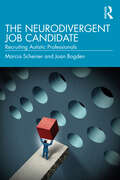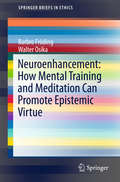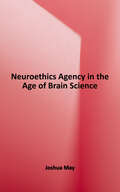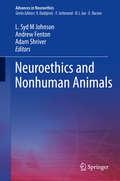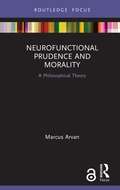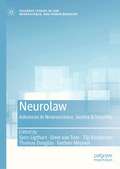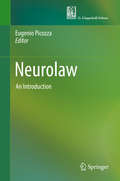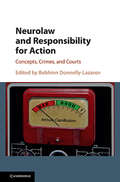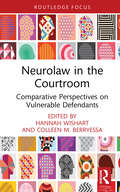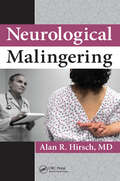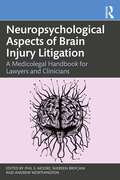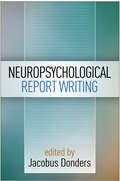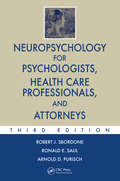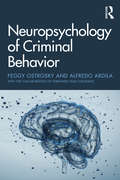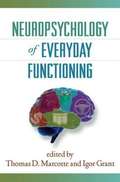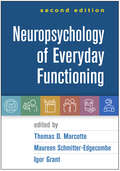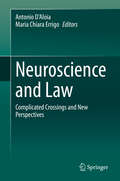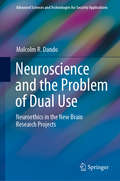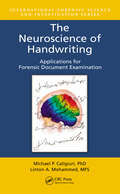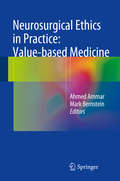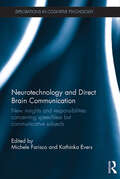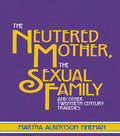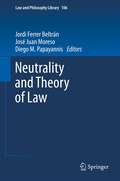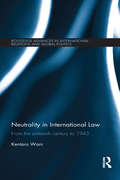- Table View
- List View
The Neurodivergent Job Candidate: Recruiting Autistic Professionals
by Joan Bogden Marcia ScheinerThis book provides guidance on recruiting, interviewing, and onboarding practices that will allow employers to successfully hire neurodivergent professionals into inclusive, competitive employment. Today, 35% of 18-year-olds with an autism spectrum diagnosis attend college, yet they have a 75–85% under-employment and unemployment rate after graduation. While organizations are looking to expand their diversity and inclusion hiring efforts to include neurodivergent professionals, current recruiting and interviewing practices in general are not well-suited to this. With over one-third of the US population identifying as neurodivergent, employers need to address how to attract this talent pool to take advantage of a meaningful segment of the workforce. Readers of this book will gain an understanding of how to guide their organizations through the creation of recruiting, interviewing, and onboarding processes tailored to neurodivergent professionals in any field. Written by authors with extensive experience working in the corporate world and consulting with Fortune 1000 companies on autism hiring efforts, this book is targeted at employers, acknowledging their perspective. Structured as a reference guide for busy recruiters, hiring managers, and supervisors, this book can be read in its entirety, in relevant sections as needed, or used as a refresher whenever necessary. This book also provides a background on the thinking styles of autistic individuals, giving the reader a deeper understanding of how to best support neurodivergent jobseekers.
Neuroenhancement: how mental training and meditation can promote epistemic virtue.
by Barbro Fröding Walter OsikaThis book explores how one can bring about changes in the brain through meditation, both through attention-focus training and through compassion training. Recent findings in the natural sciences have confirmed that it is possible for humans to achieve these structural and functional changes through various life-style practices. It is argued that meditation enables us to influence some aspects of our biological make-up and, for example, could boost our cognitive flexibility as well as our ability to act compassionate. Such changes are likely to facilitate the instilling of a number of epistemic virtues which have great bearing on our quality of life. This book offers the reader an accessible introduction to a set of neuro-enhancement methods, with a special focus on meditation techniques, and explores how such practices could contribute to make us better decision-makers and improve our moral virtues. The book is suitable for anyone looking for a text discussing the effects of neuro-enhancement from a secular ethics perspective.
Neuroethics: Agency in the Age of Brain Science
by Joshua MayIs free will an illusion? Is addiction a brain disease? Should we enhance our brains beyond normal? Neuroethics blends philosophical analysis with modern brain science to address these and other critical questions through captivating cases. The result is a nuanced view of human agency as surprisingly diverse and flexible. With a lively and accessible writing style, Neuroethics is an indispensable resource for students and scholars in both the sciences and humanities.
Neuroethics and Nonhuman Animals (Advances in Neuroethics)
by Andrew Fenton L. Syd M Johnson Adam ShriverThis edited volume represents a unique addition to the available literature on animal ethics, animal studies, and neuroethics. Its goal is to expand discussions on animal ethics and neuroethics by weaving together different threads: philosophy of mind and animal minds, neuroscientific study of animal minds, and animal ethics. Neuroethical questions concerning animals’ moral status, animal minds and consciousness, animal pain, and the adequacy of animal models for neuropsychiatric disease have long been topics of debate in philosophy and ethics, and more recently also in neuroscientific research. The book presents a transdisciplinary blend of voices, underscoring different perspectives on the broad questions of how neuroscience can contribute to our understanding of nonhuman minds, and on debates over the moral status of nonhuman animals. All chapters were written by outstanding scholars in philosophy, neuroscience, animal behavior, biology, neuroethics, and bioethics, and cover a range of issues and species/taxa. Given its scope, the book will appeal to scientists and students interested in the debate on animal ethics, while also offering an important resource for future researchers. Chapter 13 is available open access under a CC BY 4.0 license at link.springer.com.
Neurofunctional Prudence and Morality: A Philosophical Theory (Routledge Focus on Philosophy)
by Marcus ArvanPhilosophers across many traditions have long theorized about the relationship between prudence and morality. Few clear answers have emerged, however, in large part because of the inherently speculative nature of traditional philosophical methods. This book aims to forge a bold new path forward, outlining a theory of prudence and morality that unifies a wide variety of findings in neuroscience with philosophically sophisticated normative theorizing. The author summarizes the emerging behavioral neuroscience of prudence and morality, showing how human moral and prudential cognition and motivation are known to involve over a dozen brain regions and capacities. He then outlines a detailed philosophical theory of prudence and morality based on neuroscience and lived human experience. The result demonstrates how this theory coheres with and explains the behavioral neuroscience, showing how each brain region and capacity interact to give rise to prudential and moral behavior. Neurofunctional Prudence and Morality: A Philosophical Theory will be of interest to philosophers and psychologists working in moral psychology, neuroethics, and decision theory.
Neurolaw: Advances in Neuroscience, Justice & Security (Palgrave Studies in Law, Neuroscience, and Human Behavior)
by Gerben Meynen Sjors Ligthart Dave Van Toor Tijs Kooijmans Thomas DouglasThis edited book provides an in-depth examination of the implications of neuroscience for the criminal justice system. It draws together experts from across law, neuroscience, medicine, psychology, criminology, and ethics, and offers an important contribution to current debates at the intersection of these fields. It examines how neuroscience might contribute to fair and more effective criminal justice systems, and how neuroscientific insights and information can be integrated into criminal law in a way that respects fundamental rights and moral values.The book’s first part approaches these questions from a legal perspective, followed by ethical accounts in part two. Its authors address a wide range of topics and approaches: some more theoretical, like those regarding the foundations of punishment; others are more practical, like those concerning the use of brain scans in the courtroom. Together, they illustrate the thoroughly interdisciplinary nature of the debate, in which science, law and ethics are closely intertwined. It will appeal in particular to students and scholars of law, neuroscience, criminology, socio-legal studies and philosophy.Chapter 8 is available open access under a Creative Commons Attribution 4.0 International License via link.springer.com.
Neurolaw
by Eugenio PicozzaThis volume illustrates to the public, and legal experts, the basic principles of the field of neuroscience, that commonly goes under the name of Neurolaw. First, it illustrates the relationship between neuroscience, natural sciences and social sciences. Furthermore, it highlights numerous problems concerning the fundamental philosophical concepts used by Neurolaw and evaluates the validity of the method and the limits of a neuroscientific approach to the problems of law and justice. The volume explores the possibility of application of these concepts on the fundamentals of the general theory of law and legal dogmatics. It also examines the main problems of Neurolaw in relation to public, private, criminal and procedural law. In conclusion, the book follows a systematic method that makes it an thorough manual for the introduction to Neurolaw.
Neurolaw and Responsibility for Action: Concepts, Crimes, and Courts
by Dennis Patterson Peter Raynor Donnelly-Lazarov BebhinnLaw regulates human behaviour, a phenomenon about which neuroscience has much to say. Neuroscience can tell us whether a defendant suffers from a brain abnormality or injury, and it can correlate these neural deficits with criminal offending. Using fMRI and other technologies it might indicate whether a witness is telling lies or the truth. It can further propose neuro-interventions to ‘change’ the brains of offenders and so to reduce their propensity to offend. And, it can make suggestions about whether a defendant knows or merely suspects a prohibited state of affairs, so drawing distinctions among the mental states that are central to legal responsibility. Each of these matters has philosophical import; is a neurological ‘deficit’ inculpatory or exculpatory; what is the proper role for law if the mind is no more than the brain; is lying really a brain state, and can neuroscience really ‘read’ the brain? In this edited collection, leading contributors to the field provide new insights on these matters, bringing to light the great challenges that arise when disciplinary boundaries merge.
Neurolaw in the Courtroom: Comparative Perspectives on Vulnerable Defendants (Routledge Contemporary Issues in Criminal Justice and Procedure)
by Hannah Wishart and Colleen M. BerryessaThis collection presents a comparative perspective on interdisciplinary issues that fall under the emerging field of Neurolaw. The chapters embrace distinct procedural and evidential issues in the courtroom for vulnerable defendants, such as immature defendants, mentally disordered offenders and unfit-to-plead defendants, through a neuroscientific lens. This view is informed by worldwide analyses from legal academics, philosophers, and legal practitioners. The work brings together interdisciplinary and leading perspectives to discuss the use and relevancy of neuroscience at trial, and how the use of neuroscience is currently benefiting and impacting vulnerable defendants in global criminal trials. As such, the book builds upon and adds to the existing literature in this field by providing a comprehensive coverage of the intersection between these disciplines for vulnerable defendants in the courtroom. Key issues covered include: vulnerable defendants and the pre-trial process; the trial process; the use of neuroscience as expert evidence at trial; and vulnerable defendants, neuroscience and mitigation of sentence. Through original exploration presented by contributors from both academia and practice, the book will be of interest to academics, researchers and policy-makers working in the areas of Criminal Law and Procedure.
Neurological Malingering
by Alan R. HirschWritten from the viewpoint of the practicing clinician, this text is an indispensable addition to the library of anyone who is in the practice of medicine, osteopathy, or chiropractic, as well as for the judge, lawyer, or social worker who may interact with those presenting with the possibility of malingering. Other topics discussed include Waddell’s Signs, the Pinocchio Phenomenon, the Othello Error, the Menace Reflex, the Reliable Digit Span, Lombard’s Test, the Babinski Sign of the Eyebrow, the Hummel Double Conversation Test, the Swinging Story Test, the Judd-Persaud Test, the Teal Test, the Chimani-Moos Test, the Occlusion Effect, the Drop Arm Test, the Drop Leg Test, the Honest Palm Sign, the Elbow-Flex-Ex Sign, Beevor's Sign, Schober's Test, the Babinski Trunk-Thigh Test, and the Barré Test. Advance praise for Neurological Malingering "Dr. Hirsch’s book is long overdue and covers a critical topic of concern to all medical practitioners. This comprehensive treatise is a must for all physicians, psychologists, and others who work with patients who have incentive to gain from the system. Multiple topics related to malingering are presented in 16 straightforward chapters never before compiled in a single volume. I recommend this book highly to anyone concerned about malingering and its impact on the medical system." - Richard L. Doty, PhD, FAAN, Professor and Director, Smell and Taste Center, Perelman School of Medicine, University of Pennsylvania "Malingering affects not only the malingerers, but the persons and institutions around them as well. As a lay person, the readings have certainly made me considerably more sensitive to suspect behavior. And where knowledge of the underlying condition can affect relationships or transactions one is associated with, it is certainly useful to not only recognize its existence, but also to put it within the context of the challenges that it presents to those relationships or transactions. I count the time spent reading this most comprehensive work as well spent. I would further recommend it to others whose interests, decisions and/or professional pursuits could very well be affected by malingering, whether the behavior is or is not purposeful." - Judge Stephen A. Schiller (Retired), Circuit Court of Cook County, Illinois
Neuropsychological Aspects of Brain Injury Litigation: A Medicolegal Handbook for Lawyers and Clinicians
by Phil S. MooreThis accessible handbook focuses on the importance of neuropsychological evidence and the role of the neuropsychologist as expert witness in brain injury litigation. This thorough, evidence-based resource fosters discussion between the legal profession and expert neuropsychological witnesses. The chapters reflect collaborations between leading personal injury lawyers and neuropsychologists in the UK. Key issues in brain injury litigation are addressed that are essential to an understanding of the role of the neuropsychologist as expert witness and of neuropsychological evidence for the courts. These include neuropsychological testing, assessment of quantum, vocational rehabilitation, mental capacity, forensic outcomes, the frontal paradox, mild traumatic brain injury and more. Combining the scientific and legal background with practical tips and case examples, this book is valuable reading for legal professionals, particularly those working in personal injury and clinical negligence, as well as trainees, students and clinicians in the field of neuropsychology, neurorehabilitation and clinical psychology.
Neuropsychological Report Writing (Evidence-Based Practice in Neuropsychology)
by Jacobus DondersAll neuropsychologists need to know how to produce evidence-based reports. This book brings together experts to provide an in-depth guide to high-quality report writing in a range of contexts, including evaluations of older adults, psychiatric patients, those with complex medical conditions, schoolchildren, and others. It reviews the fundamental elements of a clinical neuropsychological report and shows how to tailor findings, conclusions, and recommendations to particular audiences, such as referring physicians, school professionals, and legal decision makers. Of special utility, every chapter features excerpts of sample reports, including examples of strong and poor documentation of the same material.
Neuropsychology for Psychologists, Health Care Professionals, and Attorneys (Rob & Smith's Operative Surgery Series)
by Robert J. Sbordone Ronald E. Saul Arnold D. PurischExtensively revised and expanded, this third edition of Neuropsychology for Psychologists, Health Care Professionals, and Attorneys provides a clear, concise, and comprehensive discussion of neuropsychology, outlining its purpose, use, and historical development. It covers the anatomy of the brain, a wide variety of neurobehavioral disorders, compr
Neuropsychology of Criminal Behavior
by Feggy Ostrosky Alfredo ArdilaThis book draws on findings from psychology, neurology, and genetics, to offer a multi-dimensional analysis of criminal behavior. It explores the biological bases of emotions such as aggression, anger, and hostility and how they-- combined with social psychological influences, such as family history and environmental conditions-- may lead to violence. Specific case studies, including serial killings, mass murders, family violence, cannibalism, and hitmen, are referenced throughout, providing real-world examples of these theories in action. Issues of free will and the law are discussed as well as suggestions for curbing violent behavior.
Neuropsychology of Everyday Functioning
by Igor Grant Thomas MarcotteWhile neuropsychological testing can accurately detect cognitive deficits in persons with brain injury, the ability to reliably predict how these individuals will function in everyday life has remained elusive. This authoritative volume brings together well-known experts to present recent advances in the neuropsychological assessment of key real-world capacities the ability to live independently, work, manage medications, and drive a car. For each of these domains, contributors describe cutting-edge tests, procedures, and interpretive strategies and examine salient theoretical and methodological issues. Chapters also review approaches for evaluating specific populations, including older adults and patients with traumatic brain injury, depression, dementia, schizophrenia, and other neurological and psychiatric disorders.
Neuropsychology of Everyday Functioning, Second Edition
by Thomas D. Marcotte Maureen Schmitter-Edgecombe Igor GrantThe go-to resource for assessing and predicting functional abilities in persons with brain injury or cognitive decline has now been revised and expanded to reflect significant advances in the field. With a focus on key real-world capacities--independent living, vocational functioning, medication management, and driving--leading experts explore how individuals go about their daily lives, where and why disruptions occur, and potential opportunities for improving function. Strategies for direct assessment are reviewed, from standard neuropsychological tests to multimodal approaches and technology-based tools. Chapters also provide functional assessment guidance for specific neurological and psychiatric conditions: dementia, traumatic brain injury, depression, schizophrenia, and others. New to This Edition *Incorporates over a decade of technological and methodological innovations. *Chapter on theories and models of everyday functioning. *Chapters on naturalistic assessment, wearable sensors, ambulatory assessment, and virtual-reality-based tools. *Practical clinical implications are highlighted throughout.
Neuroscience and Law: Complicated Crossings and New Perspectives
by Antonio D’Aloia Maria Chiara ErrigoThere have been extraordinary developments in the field of neuroscience in recent years, sparking a number of discussions within the legal field. This book studies the various interactions between neuroscience and the world of law, and explores how neuroscientific findings could affect some fundamental legal categories and how the law should be implemented in such cases. The book is divided into three main parts. Starting with a general overview of the convergence of neuroscience and law, the first part outlines the importance of their continuous interaction, the challenges that neuroscience poses for the concepts of free will and responsibility, and the peculiar characteristics of a “new” cognitive liberty. In turn, the second part addresses the phenomenon of cognitive and moral enhancement, as well as the uses of neurotechnology and their impacts on health, self-determination and the concept of being human. The third and last part investigates the use of neuroscientific findings in both criminal and civil cases, and seeks to determine whether they can provide valuable evidence and facilitate the assessment of personal responsibility, helping to resolve cases. The book is the result of an interdisciplinary dialogue involving jurists, philosophers, neuroscientists, forensic medicine specialists, and scholars in the humanities; further, it is intended for a broad readership interested in understanding the impacts of scientific and technological developments on people’s lives and on our social systems.
Neuroscience and the Problem of Dual Use: Neuroethics in the New Brain Research Projects (Advanced Sciences and Technologies for Security Applications)
by Malcolm R. DandoThis book discusses recent brain research and the potentially dangerous dual-use applications of the findings of these research projects. The book is divided into three sections: Part I examines the rise in dual-use concerns within various state’s chemical and biological non-proliferation regime’s during this century, as well as the rapid technologically driven advances in neuroscience and the associated possible misuse considerations in the same period. Part II reviews the brain research projects in the EU, USA, Japan, China and several other countries with regard to their objectives, achievements and measures to deal with the problem of dual-use. Part III assesses the extent to which the results of this civil neuroscience work, which is intended to be benign, are being, and could be protected against future hostile applications in the development of novel chemical and biological weapons.
The Neuroscience of Handwriting: Applications for Forensic Document Examination (International Forensic Science And Investigation Ser.)
by Michael P. Caligiuri Linton A. MohammedThe Daubert trilogy of U.S. Supreme Court cases has established that scientific expert testimony must be based on science grounded in empirical research. As such, greater scrutiny is being placed on questioned document examination generally, and handwriting comparison in particular. Bridging the gap between theory and practice, The Neuroscience of
Neurosurgical Ethics in Practice: Value-based Medicine
by Ahmed Ammar Mark BernsteinGood neurosurgical practice is based not only on evidence, skills, and modern equipment, but also on good values. This book is the first to discuss specifically the ethical issues that arise during the daily practice of neurosurgery. It is divided into three parts addressing patients' rights, ethical issues relating to the working environment, and wider societal aspects such as dealings of neurosurgeons with the legal system, the media, and companies. The authors are well-established neurosurgeons who present the ethical problems that they have encountered during their careers and explain what they have learned in confronting these problems. In all, more than 50 neurosurgical cases drawn from real life are reported and discussed from an ethical point of view. This book will be especially informative for young neurosurgeons and will provide all who work in this very special field with a road map on how to avoid violations of medical ethics in neurosurgical practice.
Neurotechnology and Direct Brain Communication: New insights and responsibilities concerning speechless but communicative subjects (Explorations in Cognitive Psychology)
by Michele Farisco Kathinka EversNeurotechnology and Direct Brain Communication focuses on recent neuroscientific investigations of infant brains and of patients with disorders of consciousness (DOC), both of which are at the forefront of contemporary neuroscience. The prospective use of neurotechnology to access mental states in these subjects, including neuroimaging, brain simulation, and brain computer interfaces, offers new opportunities for clinicians and researchers, but has also received specific attention from philosophical, scientific, ethical, and legal points of view. This book offers the first systematic assessment of these issues, investigating the tools neurotechnology offers to care for verbally non-communicative subjects and suggesting a multidisciplinary approach to the ethical and legal implications of ordinary and experimental practices. The book is divided into three parts: the first and second focus on the scientific and clinical implications of neurological tools for DOC patient and infant care. With reference to these developments, the third and final part presents the case for re-evaluating classical ethical and legal concepts, such as authority, informed consent, and privacy. Neurotechnology and Direct Brain Communication will appeal to researchers and postgraduate students in the fields of cognitive science, medical ethics, medical technology, and the philosophy of the mind. With implications for patient care, it will also be a useful resource for clinicians, medical centres, and health practitioners.
The Neutered Mother, The Sexual Family and Other Twentieth Century Tragedies
by Martha Albertson FinemanCalling for nothing less than a radical reform of family law and a reconception of intimacy, The Neutered Mother, The Sexual Family, and Other Twentieth Century Tragedies argues strongly against current legal and social policy discussions about the family because they do not have at their core the crucial concepts of caregiving and dependency, as well as the best interests of women and children. The Neutered Mother scrutinizes the definitions of family and mother throughout the volume while paying close attention to issues of race, class and sexuality. In addition, Fienman convincingly contests society's refusal to dignify, support and respond to the needs of caregivers and illustrates the burden they must bear due to this treatment. This book is a crucial step toward defining America's most pressing social policy problems having to do with women, motherhood and the family.
Neutrality and Theory of Law
by Diego M. Papayannis Jordi Ferrer Beltrán José Juan MoresoThis book brings together twelve of the most important legal philosophers in the Anglo-American and Civil Law traditions. The book is a collection of the papers these philosophers presented at the Conference on Neutrality and Theory of Law, held at the University of Girona, in May 2010. The central question that the conference and this collection seek to answer is: Can a theory of law be neutral? The book covers most of the main jurisprudential debates. It presents an overall discussion of the connection between law and morals, and the possibility of determining the content of law without appealing to any normative argument. It examines the type of project currently being held by jurisprudential scholarship. It studies the different approaches to theorizing about the nature or concept of law, the role of conceptual analysis and the essential features of law. Moreover, it sheds some light on what can be learned from studying the non-essential features of law. Finally, it analyzes the nature of legal statements and their truth values. This book takes the reader a step further to understanding law.
Neutrality in International Law: From the Sixteenth Century to 1945 (Routledge Advances in International Relations and Global Politics)
by Kentaro WaniNeutrality is a legal relationship between a belligerent State and a State not participating in a war, namely a neutral State. The law of neutrality is a body of rules and principles that regulates the legal relations of neutrality. The law of neutrality obliges neutral States to treat all belligerent States impartially and to abstain from providing military and other assistance to belligerents. The law of neutrality is a branch of international law that developed in the nineteenth century, when international law allowed unlimited freedom of sovereign States to resort to war. Thus, there has been much debate as to whether such a branch of law remains valid in modern international law, which generally prohibits war and the use of force by States. While there has been much debate regarding the current status of neutrality in modern international law, there is a general agreement among scholars as to the basic features of the traditional law of neutrality. Wani challenges the conventional understanding of the traditional neutrality by re-examining the historical development of the law of neutrality from the sixteenth century to 1945. The modification of the conventional understanding will provide a fundamentally new framework for discussing the current status of neutrality in modern international law.
Never Again: Germans and Genocide after the Holocaust
by Andrew I. PortGermans remember the Nazi past so that it may never happen again. But how has the abstract vow to remember translated into concrete action to prevent new genocides abroad?As reports of mass killings in Bosnia spread in the middle of 1995, Germans faced a dilemma. Should the Federal Republic deploy its military to the Balkans to prevent a genocide, or would departing from postwar Germany’s pacifist tradition open the door to renewed militarism? In short, when Germans said “never again,” did they mean “never again Auschwitz” or “never again war”?Looking beyond solemn statements and well-meant monuments, Andrew I. Port examines how the Nazi past shaped German responses to the genocides in Cambodia, Bosnia, and Rwanda—and further, how these foreign atrocities recast Germans’ understanding of their own horrific history. In the late 1970s, the reign of the Khmer Rouge received relatively little attention from a firmly antiwar public that was just “discovering” the Holocaust. By the 1990s, the genocide of the Jews was squarely at the center of German identity, a tectonic shift that inspired greater involvement in Bosnia and, to a lesser extent, Rwanda. Germany’s increased willingness to use force in defense of others reflected the enthusiastic embrace of human rights by public officials and ordinary citizens. At the same time, conservatives welcomed the opportunity for a more active international role involving military might—to the chagrin of pacifists and progressives at home.Making the lessons, limits, and liabilities of politics driven by memories of a troubled history harrowingly clear, Never Again is a story with deep resonance for any country confronting a dark past.
